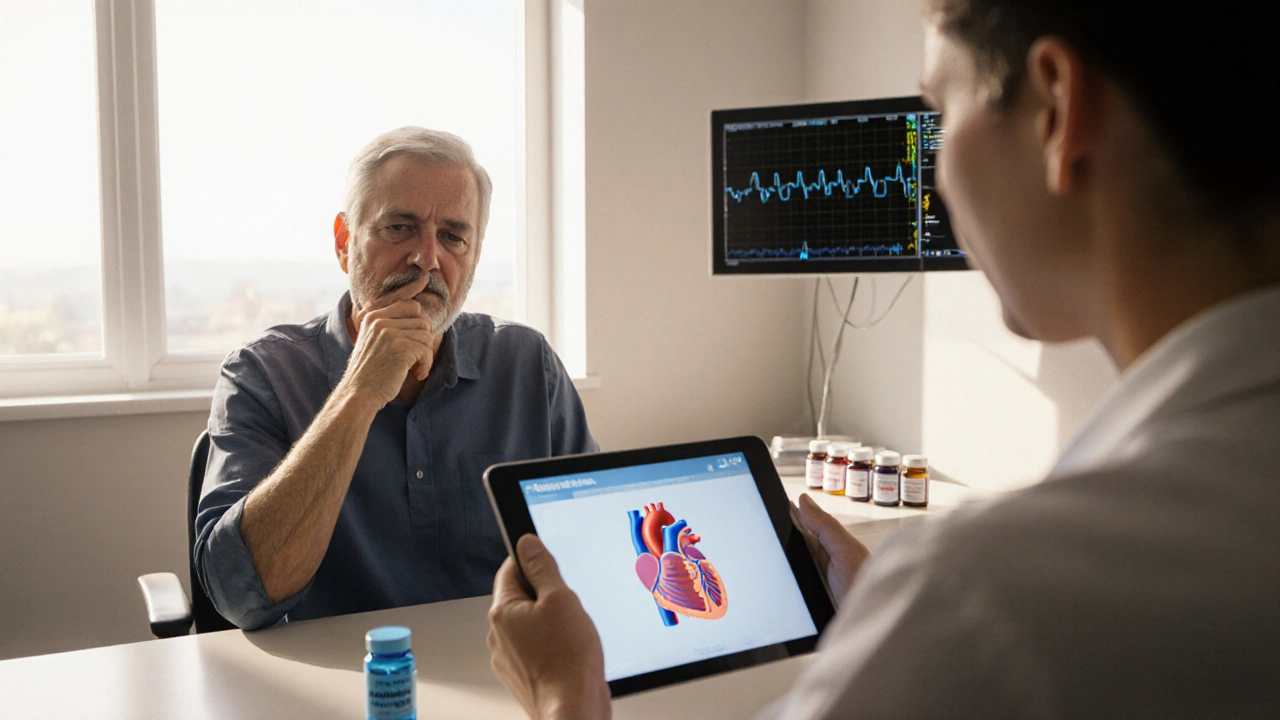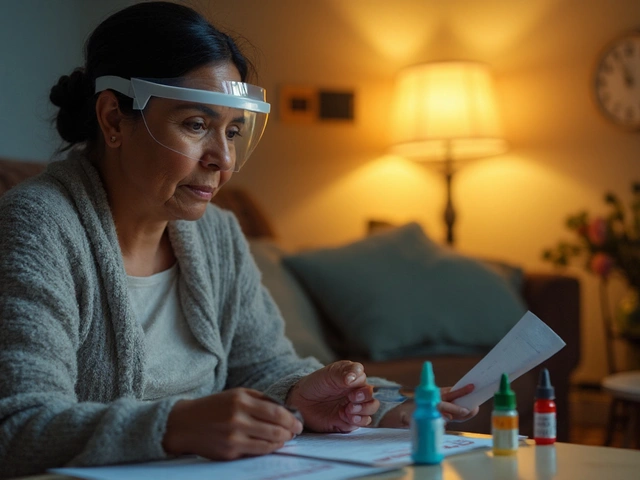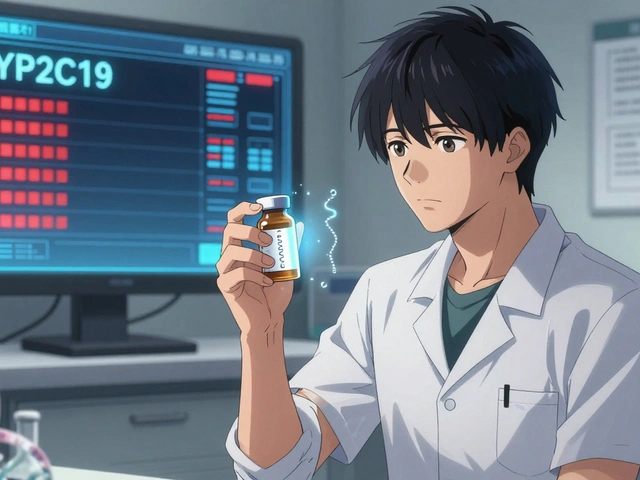Amiodarone vs Alternatives Decision Guide
Enter your medical profile and click "Analyze Treatment Options"
| Drug | Primary Use | Strengths | Limitations |
|---|---|---|---|
| Amiodarone | AF, VT, VF | Broad spectrum, effective for multiple rhythms | Organ toxicity, complex monitoring |
| Sotalol | AF, VT | Good for AF/VT, lung-safe | QT prolongation risk, requires monitoring |
| Dronedarone | AF maintenance | No iodine, lower toxicity | Not for VT, liver risk |
| Flecainide | Lone AF | Strong efficacy in normal hearts | Unsafe in structural heart disease |
| Catheter Ablation | AF, VT, flutter | Potential cure, no long-term meds | Procedure-based, requires expertise |
When doctors need to steady a shaky heart rhythm, Amiodarone is often the go‑to choice. It’s sold under the brand name Cordarone, works on almost every part of the electrical system, and can handle both atrial fibrillation (AF) and ventricular tachycardia (VT). The flip side? It carries a baggage of side effects that can show up months after you start taking it. That’s why many patients and clinicians start looking at Amiodarone alternatives before committing to a long‑term plan.
Quick Take
- Amiodarone is powerful but heavy on organ toxicity.
- Sotalol is easier on the lungs but needs careful QT monitoring.
- Dronedarone avoids iodine‑related issues but isn’t as strong for VT.
- Flecainide and Propafenone are great for “lone” AF but unsafe in structural heart disease.
- Non‑drug option: catheter ablation offers a cure‑like solution for many rhythm problems.
How Anti‑arrhythmic Drugs Differ
Anti‑arrhythmics fall into four classes (the classic Vaughan‑Williams system). Amiodarone is a ClassIII drug with a little bit of everything - it blocks potassium, sodium, calcium channels and even some beta‑receptors. The alternatives each lean toward a single class, which shapes their strengths and weaknesses.
Key Alternatives Explained
Below is a snapshot of the most common substitutes. Each name appears with its first definition wrapped in microdata, so search engines can pull out the core facts.
Sotalol is a ClassIII anti‑arrhythmic that also blocks beta‑receptors, making it useful for both AF and VT while sparing the thyroid and lungs.
Dronedarone is a non‑iodinated analogue of amiodarone, classified as ClassIII, designed to reduce organ toxicity but with less potency for serious ventricular arrhythmias.
Flecainide belongs to ClassIC, offering fast sodium‑channel blockade, ideal for patients with lone AF and no structural heart disease.
Propafenone is another ClassIC agent that adds weak beta‑blocking effects, useful for symptomatic AF in otherwise healthy hearts.
Dofetilide is a pure ClassIII potassium‑channel blocker, prescribed for AF when other drugs fail, but requires hospital‑based initiation due to QT‑prolongation risk.
Ibutilide is a short‑acting ClassIII agent used primarily to revert recent‑onset AF or flutter, administered intravenously in a monitored setting.
Catheter Ablation is a procedural alternative that isolates or destroys the tissue triggering arrhythmia, offering a potential cure without long‑term drug exposure.
Side‑Effect Profiles at a Glance
Understanding the trade‑offs is crucial. Amiodarone’s biggest culprits are thyroid dysfunction, pulmonary fibrosis, liver enzyme elevation, and skin discoloration. Sotalol’s main concern is QT‑interval prolongation, which can precipitate torsades de pointes if electrolytes are low. Dronedarone avoids thyroid and lung issues but still carries a risk of liver injury and can increase mortality in severe heart failure. Flecainide and propafenone can provoke pro‑arrhythmia in damaged hearts. Dofetilide and ibutilide demand strict QT monitoring and are usually started in a hospital.

Decision‑Making Checklist
- Is the patient’s heart structurally normal? If yes, ClassIC drugs (flecainide, propafenone) are strong candidates.
- Do we need a drug that works for both AF and VT? Amiodarone or sotalol may be the only options.
- Is there a history of thyroid or lung disease? Skip amiodarone; consider dronedarone or sotalol.
- Can the patient tolerate regular ECG checks? Hospital‑based initiation (dofetilide, ibutilide) requires strict follow‑up.
- Is the patient a good procedural candidate? If yes, refer for catheter ablation instead of long‑term meds.
Side‑by‑Side Comparison Table
| Drug / Option | Primary Indications | Mechanism | Typical Dose | Major Side Effects | Monitoring Needs |
|---|---|---|---|---|---|
| Amiodarone | AF, VT, VF | Multi‑class (K⁺, Na⁺, Ca²⁺, β) | 200mgdaily (maintenance) | Thyroid, lung, liver, skin | Thyroid labs, LFTs, chest X‑ray, ECG |
| Sotalol | AF, VT | ClassIII K⁺ block + β‑block | 80‑160mgbid | QT prolongation, bradycardia | Frequent ECG, electrolytes |
| Dronedarone | AF (maintain), not VT | ClassIII K⁺ block (no iodine) | 400mgbid | Liver, GI upset, heart failure risk | LFTs, ECG, HF screen |
| Flecainide | Lone AF, PSVT | ClassIC Na⁺ block | 100‑200mgbid | Pro‑arrhythmia in CAD/CHF | ECG, structural heart eval |
| Propafenone | Lone AF, SVT | ClassIC Na⁺ block + β‑block | 150‑300mgbid | Same as flecainide, taste disturbance | ECG, structural heart eval |
| Dofetilide | AF refractory | ClassIII K⁺ block | 125‑500µgbid (adjusted) | QT prolongation, torsades | In‑hospital initiation, QT monitoring |
| Ibutilide | Recent‑onset AF/flutter | ClassIII K⁺ block (IV) | 1mgIV over 10min | QT prolongation, hypokalemia | Continuous ECG for 4‑6h |
| Catheter Ablation | AF, typical flutter, VT | Electrophysiologic lesioning | Procedure‑based | Puncture complications, rare stroke | Post‑procedure ECG, anticoagulation |
Choosing the Right Path for You
Imagine you’re sitting with your cardiologist. The doctor asks: “Do you have any liver or thyroid issues?” If you say yes, amiodarone probably slides down the list. If you’re a young athlete with a clean heart, a ClassIC pill like flecainide might feel more like a fit‑and‑finish. For older patients with heart failure, dronedarone’s safety profile can be a lifesaver-just not for those with severe LV dysfunction.
Procedural routes are gaining ground. Studies published in 2024 show that for paroxysmal AF, first‑line catheter ablation reduces hospital readmissions by 30% compared with a drug‑first strategy. That’s a compelling number if you dislike daily pills.
Practical Tips for Patients Starting a New Anti‑arrhythmic
- Write down every medication you already take-some anti‑arrhythmics interact with statins, anticoagulants, or antidepressants.
- Ask for a baseline ECG and labs (thyroid, liver, kidney) before the first dose.
- Set a reminder for follow‑up labs. Missing a thyroid test while on amiodarone can let hypothyroidism go unchecked for months.
- Know the red‑flag symptoms: sudden shortness of breath (lung toxicity), yellowing of skin (liver), unexplained weight gain (thyroid).
- Keep an emergency contact list. If you develop palpitations with dizziness, call your clinic right away.
Frequently Asked Questions
Can I switch from amiodarone to another drug safely?
Switching is possible but must be done under medical supervision. Typically, doctors taper amiodarone slowly to avoid rebound arrhythmias while introducing the new agent. Blood tests and ECGs guide the timing.
Why is amiodarone called a “broad‑spectrum” anti‑arrhythmic?
It blocks potassium, sodium, calcium channels and also has beta‑blocking activity. That multi‑target approach lets it treat almost any tachyarrhythmia, from AF to life‑threatening VT.
Is sotalol safer for people with lung disease?
Yes, sotalol does not irritate the lungs the way amiodarone can. However, it still requires close QT monitoring, especially if you have electrolyte imbalances.
When is catheter ablation preferred over medication?
Ablation is often first‑line for symptomatic paroxysmal AF, especially in patients under 70 who want to avoid lifelong drugs. It’s also chosen when medicines fail or cause intolerable side effects.
Do any of these drugs affect pregnancy?
Amiodarone is generally avoided in pregnancy because of potential fetal thyroid suppression. Flecainide and propafenone are also contraindicated if the mother has structural heart disease. Sotalol can be used cautiously, but a specialist should evaluate risks.
Choosing an anti‑arrhythmic isn’t a one‑size‑fits‑all decision. By weighing the heart condition, comorbidities, and lifestyle preferences, you and your doctor can land on the option that balances effectiveness with safety.









Tiarna Mitchell-Heath
Look, the moment you start cherry‑picking drugs based on a generic checklist, you’re already selling yourself short. Amiodarone’s “broad‑spectrum” label isn’t a badge of honor; it’s a red flag for organ toxicity that most patients can’t afford. If your doctor isn’t banging on about thyroid panels and lung scans before prescribing, they’re dodging responsibility. Pull the trigger on a safer alternative now, or regret it later.
Katie Jenkins
First off, the article does a solid job of laying out the pharmacodynamics, but there’s a glaring omission: the cost‑effectiveness analysis. Amiodarone may be cheap per tablet, yet the downstream expenses-regular LFTs, thyroid panels, and potential hospitalizations-can easily eclipse that savings. Moreover, the comparison table should include NOTCH‑related trials that were published last year, which show a modest mortality benefit for sotalol in select heart‑failure cohorts. Lastly, the formatting could use consistent use of periods after table headings for better readability.
Jack Marsh
While the preceding summary appears comprehensive, it neglects to acknowledge that the purported superiority of sotalol in certain heart‑failure subsets remains statistically nonsignificant after Bonferroni correction. Additionally, the article’s assertion that dronedarone “avoids iodine‑related issues” overlooks the compound’s documented hepatic toxicity, which has led to FDA warnings. A rigorous meta‑analysis would have clarified these ambiguities rather than presenting unqualified statements. Consequently, readers may develop an inflated perception of safety regarding these alternatives.
Steven Waller
It’s vital to remember that each anti‑arrhythmic exists within a therapeutic ecosystem, where patient‑specific factors dictate optimal choice. When evaluating options, consider not only electrophysiological efficacy but also quality‑of‑life metrics-exercise tolerance, symptom burden, and psychosocial impact. Engaging patients in shared decision‑making fosters adherence and empowers them to voice preferences, which often reveal hidden contraindications or tolerability concerns. Ultimately, a nuanced, individualized approach supersedes any one‑size‑fits‑all algorithm.
Puspendra Dubey
Yo bro, this whole amiodarone saga is like a never‑ending soap‑opera! 😂 You think the side‑effects are just a plot twist, but they’re the whole drama series-thyroid drama, lung drama, even skin drama! If u want a smoother ride, maybe try sotalol, it's like the chill cousin who never crashes the party. But hey, talk to your doc first, ‘cause they hold the script! 🙏
Shaquel Jackson
Amiodarone’s toxicity profile alone should keep most physicians at bay.
Tom Bon
In accordance with current clinical guidelines, the selection of an anti‑arrhythmic agent must be predicated upon a thorough assessment of structural cardiac integrity, comorbid organ function, and anticipated pharmacological interactions. Failure to incorporate these variables may precipitate adverse events that compromise both morbidity and mortality outcomes. Therefore, a systematic, evidence‑based methodology is paramount.
Clara Walker
Let’s not forget that the pharmaceutical lobby has been pushing amiodarone as the “default” drug to keep generic manufacturers in check, all while they quietly suppress data on its long‑term organ damage. This isn’t just a medical choice; it’s a strategic move to maintain market dominance under the guise of efficacy. If you truly value your health, demand transparency and consider alternatives that aren’t wrapped in corporate secrecy.
Jana Winter
The preceding comment suffers from a cascade of logical fallacies and unchecked assumptions. While skepticism toward industry influence is warranted, dismissing amiodarone outright without referencing peer‑reviewed studies betrays a lack of scholarly rigor. Moreover, the tone oscillates between alarmist rhetoric and vague insinuations, undermining credibility. A balanced appraisal should integrate both benefits and risks, anchored in verifiable data.
Linda Lavender
When one traverses the labyrinthine landscape of anti‑arrhythmic therapy, the allure of a panacea such as amiodarone is, at first glance, undeniably captivating. Its ability to quench a spectrum of tachyarrhythmias-ranging from atrial fibrillation to ventricular tachycardia-places it on a pedestal rarely accorded to other pharmacologic agents. Yet, this very breadth of action constitutes a double‑edged sword, for the molecular promiscuity that grants it versatility also begets a litany of off‑target effects. The thyroid axis, for instance, is notoriously vulnerable, with both hypo‑ and hyper‑thyroid states emerging months after initiation. Pulmonary toxicity, manifesting as interstitial fibrosis, can evolve insidiously, evading early detection until irreversible damage ensues. Hepatic enzymes, too, may climb precipitously, heralding possible cholestasis or hepatitis, while dermatologic changes-photosensitivity and a characteristic slate‑gray hue-serve as outward harbingers of internal discord. Moreover, the pharmacokinetic profile is riddled with complexities: a massive volume of distribution, prolonged half‑life extending to several weeks, and a propensity for drug–drug interactions via cytochrome P450 pathways. Such intricacies demand relentless monitoring, a burden that can strain both patient compliance and healthcare resources. In contrast, agents like sotalol, though not devoid of risk, present a more predictable safety canvas, with QT prolongation as the primary concern, mitigated through diligent electrolyte management. Dronedarone, engineered to sidestep iodine‑induced thyroid disturbances, sacrifices some anti‑ventricular potency, yet offers a comparatively gentler systemic footprint. The decision matrix, therefore, should not be predicated solely on arrhythmia suppression efficacy but must integrate organ tolerance, lifestyle considerations, and the psychosocial toll of chronic surveillance. It is incumbent upon clinicians to present this mosaic of data transparently, empowering patients to weigh the scales of benefit against the specter of toxicity. Only through such shared deliberation can the myth of a universal anti‑arrhythmic be dispelled, ushering in tailored therapeutics that honor both survival and quality of life.
Jay Ram
Wow, that deep dive really lights up the hidden costs-great reminder that we shouldn’t just chase rhythm control but also protect the rest of our bodies. Keep sharing these detailed breakdowns; they empower us to ask the right questions and demand comprehensive care.
shikha chandel
The table omits beta‑blocker combos, which is a glaring oversight.